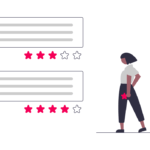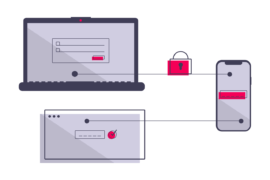Most of your users don’t care about why you need cookies; they have landed on your site to consume content and not delve into personal interaction by giving you their email addresses. They’d prefer to stay on your site without interruptions or annoying pop-ups.
But they would also like a personalised experience- which is only possible if they accept cookies or provide your site with relevant information.
Inadvertently, it falls upon the publishers to improve the consent rate of their users without appearing intrusive and nosy.
But first,
What is user consent?
Whenever a user interacts with your website, there are some data that your site collects actively via pop-ups, lead generation forms, sign-ups, and passively via cookies. This data may include users’ names, email addresses, contact information, etc.
GDPR, introduced on May 25, 2018, was launched to strengthen and protect users’ privacy via two routes- legitimate interest or consent route. In case of legitimate interest, websites must give legally justified reasons for collecting their user’s data. In the case of the consent route, publishers need to seek the user’s consent before collecting data.
In the post-GDPR world, publishers need to stay GDPR compliant by opting for the consent route. However, it is a slight problem for publishers because now it is up to the users to accept or reject cookies and fill out the sign-up form or close it altogether. Needless to say, most users choose to close the pop-up.
So what can you do to optimise the consent rate? Let’s find out.
Read More:
1. How Publishers are Preparing for the Cookieless Solutions
2. Ad Tech Predictions 2022: What Does 2022 Have in Store for Publishers?
Improve consent rate for publishers:
1. Build the right A/B testing procedure:
Running an effective A/B testing process can help you double the consent rate for publishers. How? Take a look at our 10 essential A/B testing best practices for publishers.
- Choose the right sample size for A/B testing;
- Choose the design that best suits your site;
- Choose the language or allow the users to choose their preferred language;
- Put links and CTA buttons in a way they don’t appear obstructive;
- Regularly test your ad or pop-up placement;
- Ask your visitors for feedback.
A/B testing can tell you which layout gets the most opt-ins. Unfortunately, it won’t tell you the user experience. So, it’s crucial to consider UX and include UX testing in your A/B testing.
2. Best CPM optimisation tool to go:
Most publishers use CMPs, that is, consent management platforms for consent management. A CMP works as per IAB’s standards of transparency and consent framework. CMPs are the companies that specialise in helping publishers’ sites achieve GDPR compliance.
A CMP tool aims to improve the consent rate for publishers. In the first interaction, the site informs the user about collecting data. It then records the consent in the admin panel, wherein the publisher reviews the consent in the dashboard. This includes:
- the user’s name,
- the time when the consent was given,
- what the user has given the consent for.
However, it must be noted that consent is not permanent, and users can withdraw their consent when they want to. You can refer to our guide to consent management platforms for more details.
3. Friction-less consent:
Many publishers have more than one domain with the same audiences. But they take consent separately on each website. The user may feel annoyed at being asked to repeatedly accept or reject cookies. It may cause unwanted friction where publishers can lose consent they have already acquired because the visitor may reject cookies upon being asked repeatedly.
Similar friction will occur when the user visits your site from a different device and is again asked to accept or deny the cookies. It can look like a bad user experience. To improve consent rate, publishers can make use of CMPs to help them with consent tracking cross-device and each domain.
Read More:
1. How Publishers Can Use Blockchain in Their Operations
2. Data Clean Rooms: What Publishers Need to Know
4. Provide users with options to choose from:
Publishers are not using cookies for targeting purposes. Publishers use some cookies to collect log-in information and user preferences to have a good user experience.
Many publishers go for the ‘accept all or reject all’ approach. A good way to improve the consent rate is for publishers to add customising settings- because then the user may not reject all the cookies.
It will also serve as a good user experience because publishers give users more control over what they want to accept and reject.
5. Personalised User Experience:
Publishers can personalise their cookie consent messages by using different languages for their users based on their demographics. You can also opt for a design layout that works best for users with similar behavioural traits.
For example, users may accept cookies if the pop-up is not too intrusive and doesn’t take up too much space.
Simply put, you have to regularly test what works best for your website while improving the consent rate. While checking and optimising, be mindful of the user experience to deliver a more personalised experience to your users.
In the wake of cookieless data for publishers, websites can include data collecting and recording user-friendly measures- first-party cookies, second-party cookies, identity graphs, Universal IDs, etc.
In Ending
To improve the consent rate for publishers, they don’t need to work with multiple tools. Only one effective or tailored CMP can help solve their consent rate optimisation. Publishers can always opt for a CMP based on their requirements. Consent rate optimisation is continuous and doesn’t stop at one A/B testing result. Thrive to be a trustworthy site so that your users don’t hesitate in providing you with their consent.
Improve Consent rate for Publishers- FAQs
CMPs, as explained above, are software which helps publishers define their cookie policies, gather and record user consent, complying GDPR, CCPA policies and regulations.
Consent rate optimisation is a tool for publishers to help maximise their user-consent rate through a variety of functions- A/B testing, template targeting, reduced cross-device and cross-domain friction and authenticated consent.
There are 113 registered CMPs available in the market; Quantcast, OneTrust, Captify, Iuebenda, etc., are some of the best ones available to the publishers. You can read more about them here.

Shubham is a digital marketer with rich experience working in the advertisement technology industry. He has vast experience in the programmatic industry, driving business strategy and scaling functions including but not limited to growth and marketing, Operations, process optimization, and Sales.







